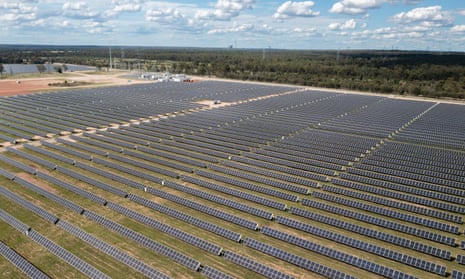Anthony Albanese will need to increase Australia’s investment in the renewable energy sector to $10bn a year over the coming decade if it is to stay in the global clean energy “arms race”, industry modelling shows.
The prime minister has indicated he will look to accelerate the transition to low emissions after Saturday’s Indigenous voice referendum as countries around the world move more quickly than expected to combat the climate crisis.
The federal government has committed billions so far in its efforts to achieve its promised national emissions reduction target of 43% by 2030 with an 82% share of renewables in the energy grid.
But new modelling from the Clean Energy Council shows Australia will need to significantly boost its investment in the sector to around $10bn a year for at least 10 years if it is to keep up with the US and other market competitors. The council described existing funding as “insufficient”.
The US president, Joe Biden’s Inflation Reduction Act, introduced in August 2022, offers tax incentives to increase take-up of zero-carbon technologies. The package is expected to initially cost $US369bn.
The energy council’s report proposes Australia spend a proportionate amount in response to the large-scale investment commitment by one of our closest allies.
“As a mid-sized economy at significant distance from major markets and a technology taker rather than maker, Australia will need to work harder to attract investment and supply chain interest,” the report says.
“Australia has a transformative opportunity before it to leverage its tremendous renewable energy advantage for unprecedented economic expansion and green growth. But it cannot rely on its natural advantages alone to capture this opportunity.”
The bill for Australia would total $83bn to $138bn, depending on the full scale of the Inflation Reduction Act, with the report recommending the federal government commit $10bn a year for 10 years toward a nation-building clean energy transformation investment package.
after newsletter promotion
Without a large and sustained financial commitment from the federal government, the council warned Australia would remain a high-emissions economy for longer and be placed at the “back of the queue for the technology and skills we need”.
While Albanese has yet to reveal his response to Biden’s legislation, he said in September the decisions made now would determine the level of the country’s success in the coming decades.
“So my vision is a clean energy economy using the advantages that we have, the best solar resources in the world, one of the best wind resources in the world, using the resources we have under the ground – copper, lithium, vanadium, nickel – all of these critical minerals and rare earths that will be to this century what fossil fuels were in the past,” Albanese said.
“The decisions we make this decade can set Australia up for many decades ahead, and unless we make the right decisions, we will fall further behind.”
